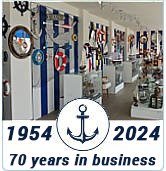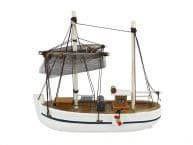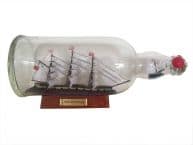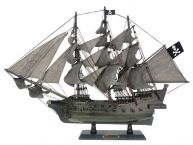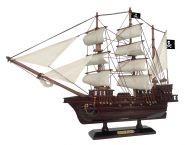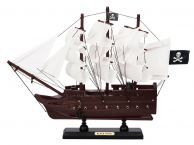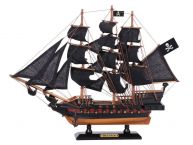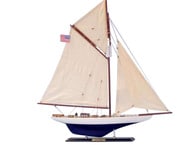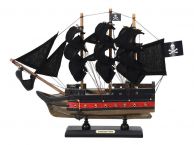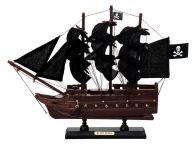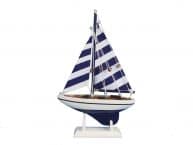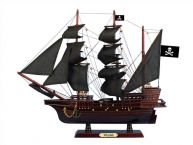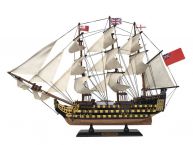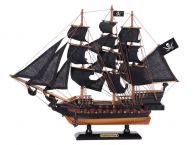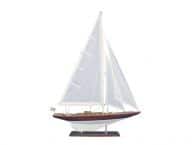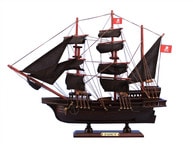|
|
Customers Also Shopped

|
|

|
Wooden Flying Dutchman Model Pirate Ship 14"
On the third of August, 1942, H.M.S. Jubilee was on the way to the Royal Navy base at Simonstown, near Cape Town. At 9 p.m., a phantom sailing ship was seen. The second officer, Davies, was in charge of the watch. Sharing this duty was the third officer, Nicholas Monsarrat, author of The Cruel Sea. Monsarrat signalled to the strange ship, but there was no response. Davies recorded in the log that a schooner, of a class that he did not recognise, was moving under full sail, even though there was no wind. The Jubilee had to change course, to avoid a collision. During the war, Davies' superiors would have been in no mood for nonsense, and he must have had to weigh that against the dangers, especially in wartime, of not recording the strange things that he saw. In an interview, Monsarrat admitted that the sighting inspired him to write his novel The Master Mariner.
According to Admiral Karl Doenitz, U Boat crews logged sightings of the Flying Dutchman, off the Cape Peninsula. For most or all of these crews, it proved to be a terrible omen. The ghostly East Indiaman was also seen at Muizenberg, in 1939. On a calm day in 1941, a crowd at Glencairn beach saw a ship with wind-filled sails, but it vanished just as it was about to crash onto the rocks. During the war years, there was plenty of room for bad omens.
The Flying Dutchman is the most famous of South Africa's hauntings, inspiring Wagner's opera Der Fliegende Hollander. Wagner, however, calls the captain himself "The Flying Dutchman". The air miles club of Royal Dutch Airlines (KLM) is also, predictably, called "The Flying Dutchman". A popular class of yacht is called "Flying Dutchman". The ghost ship provides the name for traditional English pubs, and even a great American baseball star, Honus Wagner, was nicknamed "The Flying Dutchman". You may have seen the old movie Pandora and the Flying Dutchman, starring Ava Gardner.
For centuries, the Flying Dutchman has inspired novelists. Nicholas Monsarrat has already been mentioned. Captain Frederick Marryat, most famous for his classic novels The Children Of The New Forest and Mister Midshipman Easy, was also inspired to write The Phantom Ship. Like Monsarrat, Marryat wrote his fiction after experiencing the real ghost ship. In fact, it has been suggested that Captain Marryat invented the Van der Decken character. This is not possible, however. In any case, Marryat called his fictional captain Philip Vanderdecken, not Hendrick van der Decken.
Other famous authors inspired by the legend include Washington Irving (who called the captain Ramhout van Dam) and Sir Walter Scott. Recent novels include Castaways Of The Flying Dutchman, by Brian Jacques, and Sherlock Holmes And The Ghost Of The Flying Dutchman, by Steven Fullenkamp.
Spectral ships in other parts of the world are sometimes generically called "The Flying Dutchman", but the one that still tries to round the Cape of Good Hope is the original.
The ship's captain is Hendrik van der Decken, who, in 1641, swore to round the Cape of Good Hope even if it took him till Doomsday. (Lawrence Green quoted a date of 1680 as appearing in records of the Dutch East India Company, but he was not writing at first hand. He later acknowledged that there was no record of Captain Van der Decken in the diary of the Cape Colony's governors. However, the colony was not founded until 1652. The year 1729 is quoted even less frequently). Some sources say that the voyage was from Amsterdam to Batavia, in the Dutch East Indies, but the historian Eric Rosenthal was sure that it was on the return journey to Amsterdam that the ship was lost. In some versions of the legend, the ship's captain is called Falkenburg.
Sir Walter Scott wrote of the Flying Dutchman "She is distinguished from earthly vessels by bearing a press of sail when other vessels are unable, from stress of weather, to show an inch of canvas." According to one account, the ship was painted yellow when it left Batavia, but it must have been much weathered by the time that it reached the Cape. All agree that Van der Decken tries to pass letters home to other ships, but to accept these letters is certain doom.
In what was then the British Museum library, Lawrence Green found an anonymous account of a passenger ship which did allow Van der Decken to send across a boat with four men. A Dutch seaman tried to hand letters to the passenger ship's chaplain, who wisely declined to take them. The Dutch seaman left the letters on the deck, weighted down with an iron bar, and returned to his ship. Fortunately, the passenger ship lurched, dislodging the bar, and the letters were blown overboard. The passengers survived.
Almost forgotten nowadays is another phantom Dutch East Indiaman that haunts the Cape. This is the Libera Nos, aboard which Bernard Fokke captains a literally skeleton crew. No doubt, it is sometimes mistaken for the Flying Dutchman. The Van Diemen, another Dutch ghost ship, haunts seas closer to modern day Indonesia.
The well-disciplined Royal Navy is not short of official accounts of the Flying Dutchman. The name of Captain W.F.W. Owen, a Royal Navy surveyor, occurs frequently in the annals of nineteenth century Southern Africa. One of the minor episodes of his career is recorded in the log of H.M.S. Leven, for the year 1823. Twice a phantom ship was sighted, and on one occasion it was seen to lower a boat, to attempt communication. Aware of the danger, Captain Owen did not respond.
 Handcrafted
Handcrafted Handcrafted
Handcrafted Handcrafted
Handcrafted Handcrafted
Handcrafted Handcrafted
Handcrafted Handcrafted Model Ships
Handcrafted Model Ships




